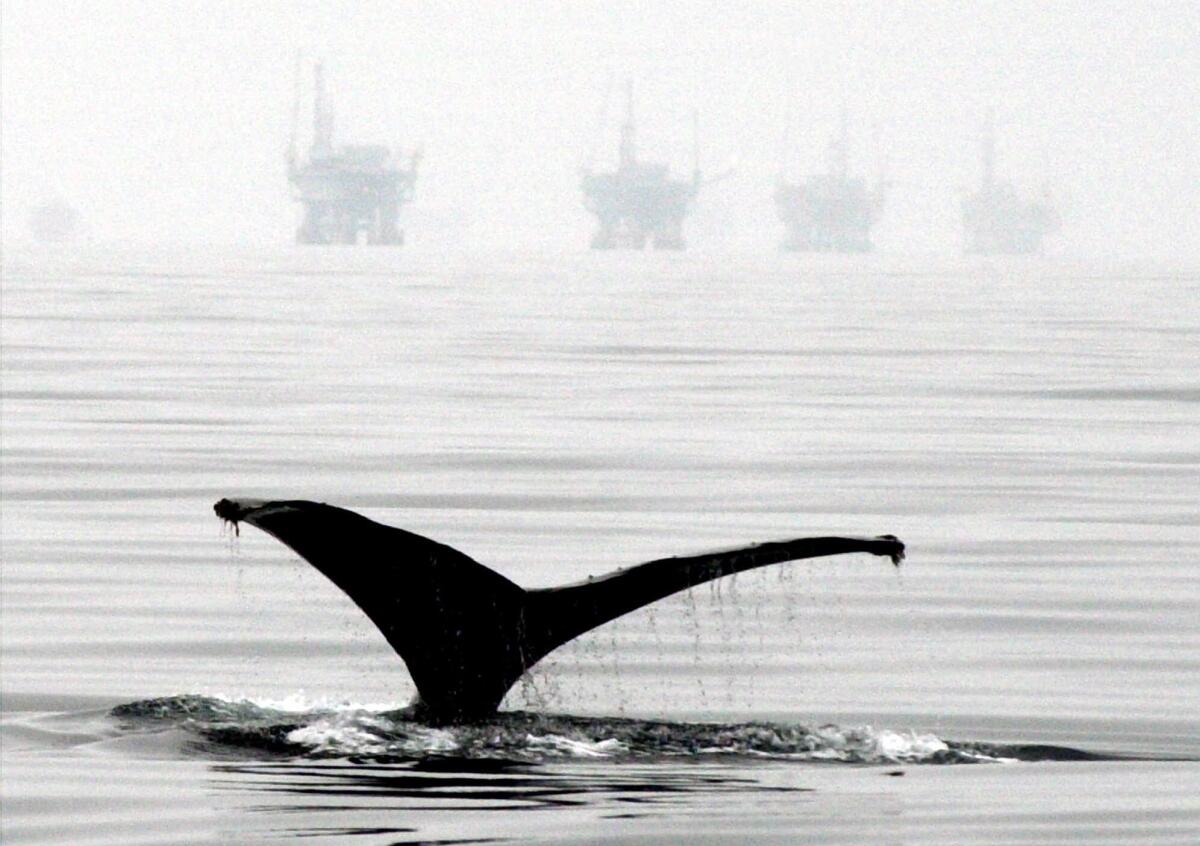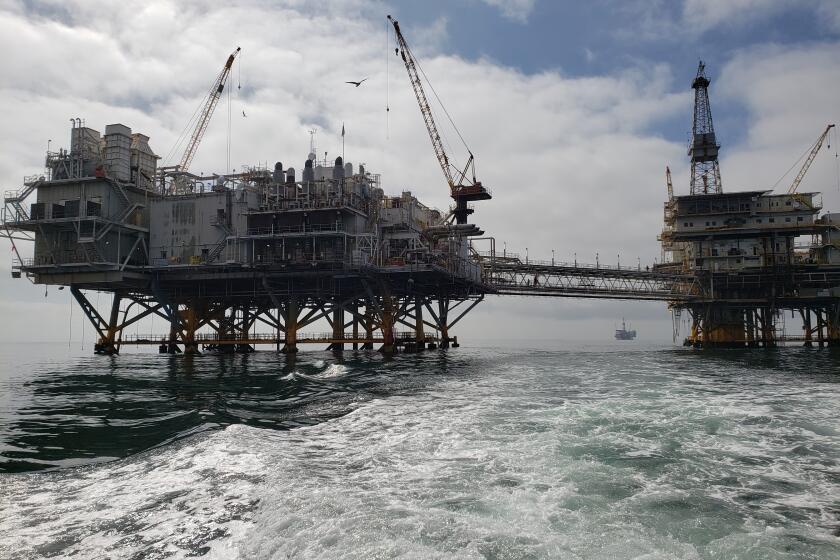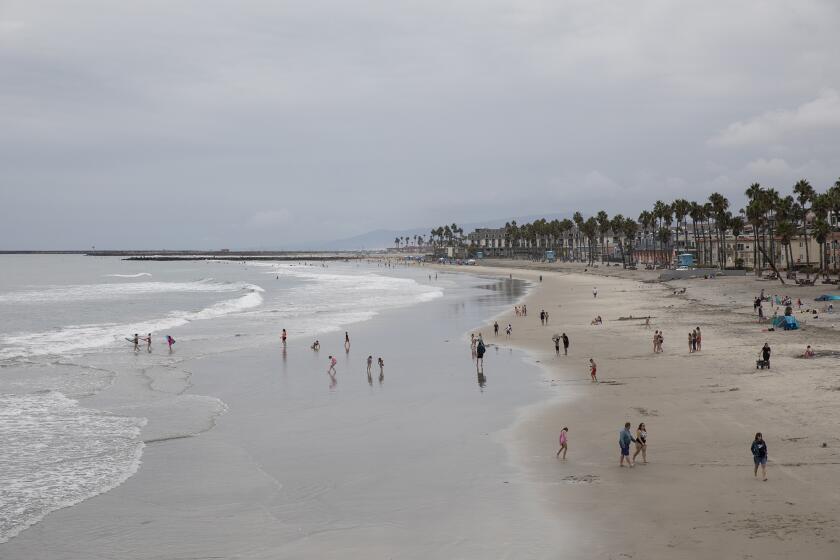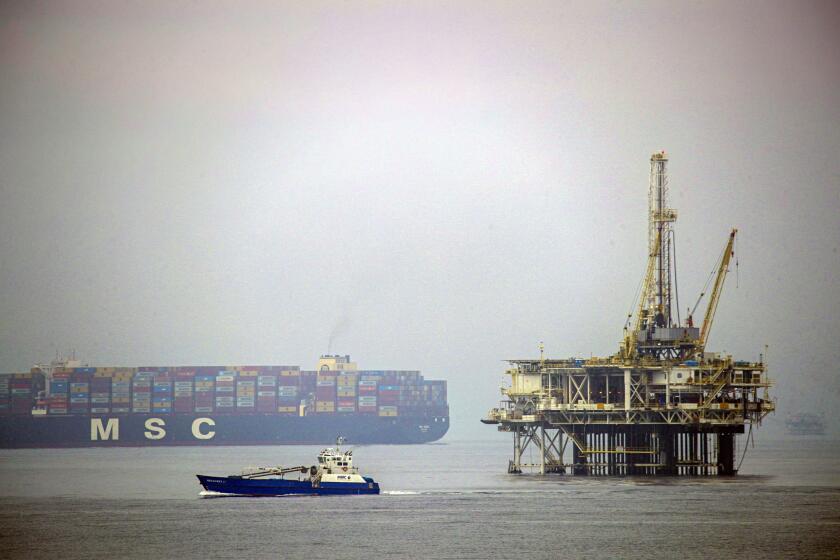California’s offshore oil rigs are decades old, and industry resists decommissioning them

- Share via
Amid a week of horror and heartbreak, outrage and demands for greater accountability, many Californians couldn’t help but question all the other oil platforms that have rusted and churned for decades just a few miles offshore.
Take Platform A, perhaps the most notorious rig of them all: On the morning of Jan. 28, 1969, this looming complex of metal off the Santa Barbara coast had ruptured the seafloor and boiled the sea black. Thousands of birds, drenched in oil, struggled to take flight. Sea otters flailed in the water. The spill became the “environmental shot heard round the world” — galvanizing the nation and forever sealing California’s distaste for offshore drilling.
Now, more than 50 years later, memories may have faded but this platform has not. Platforms A, B and C, along with more than a dozen other rigs, continue to operate — often under questionable oversight and circumstances that would seem shocking to most.
Experts and environmental advocates say this aging infrastructure will likely spark more disasters in the years ahead — as oil companies face an uncertain future, are reluctant to invest in upgrades, and hand off assets to smaller and smaller companies.
While industry officials reject this narrative, the damage unfolding from the Orange County spill — the cause of which has yet to be determined — is a harrowing reminder of what’s at risk when our beaches become fouled with oil.
“How is it that we have the 1969 oil spill and a major environmental revolution, and here we are in 2021 dealing with the same platforms and the same accidents?” said Maggie Hall, senior attorney for the Environmental Defense Center, a nonprofit environmental law firm that was created in response to the 1969 Santa Barbara spill. “Surely we’ve learned our lesson by now. ... Continuing to operate these antiquated platforms poses unacceptable risks to our marine environment — especially at a time when we’re in a climate crisis.”
Amplify Energy Corp., the owner of the offshore oil operation, had recently emerged from bankruptcy, while a subsidiary amassed numerous federal noncompliance incidents.
As California increasingly transitions to cleaner energy, its remaining offshore oil derricks might seem like relics of a fossil fuel age whose days are numbered. Yet these oil rigs are unlikely to be capped and dismantled any time soon. Oil companies have an incentive to keep them operating — in part because the costs of decommissioning are so high — or to offload them to smaller companies.
“Off the coast of California, it’s been interesting because there has been a push for all the small operators to take over,” said David Valentine, a UC Santa Barbara scientist who led major research efforts into the 2010 Deepwater Horizon disaster and 2015 Refugio spill. “So most of the big oil companies left California a long time ago because it is an inhospitable business environment for them ... and the situation or prognosis to me is even worse because [the smaller companies] don’t have the deep pockets to deal with incidents or with decommissioning.”
With little financial or regulatory incentive to shut down these structures, this hodgepodge of lesser-known corporations now operating the majority of platforms and pipelines is seemingly dug-in — eking out the last remaining oil and gas from wells that are past their prime.
These antiquated platforms have continued operating in large part, many say, by a long-held framework that dates to the Outer Continental Shelf Lands Act of 1953: The law essentially allows offshore drilling leases, once granted, to continue in perpetuity so long as the drilling operations continue.
“So basically it’s a waiting game until the leases expire, and they don’t expire until drilling production stops,” Hall said. “And it doesn’t have to be operating at a certain amount. The standard is just: The leases are continued as long as they are operating.”
Ben Oakley, manager of the California Coastal Region for Western States Petroleum Assn., pushed back on the notion that the age of platforms and infrastructure was problematic. Oakley compared California’s decades-old platforms to the Golden Gate Bridge, which dates to 1933. “It’s an old structure but it’s maintained,” Oakley said, arguing the lifespan of pipelines “is forever provided they are maintained properly and the [government] agencies are seeing to it that they are maintained.”
Oakley also pointed out that small owners are subject to the same oversight and rules as corporate giants.
“The standards don’t change,” he said.
According to a 2020 report contracted by the U.S. Bureau of Safety and Environmental Enforcement, it would cost more than $1.6 billion to decommission the 23 platforms in federal waters — which includes capping the wells, dismantling the platforms and pipelines, and disposing of the waste. Overall, that’s a 11.5% increase in cost from the bureau’s 2016 estimate.
These numbers may be an underestimate; Decommissioning Platform Holly, a rig constructed in 1966, is expected to cost $350 million.
In the case of Platform A, which is operated by DCOR, LLC — a small oil and gas company with headquarters in Oxnard and Dallas — the cost is estimated to be around $49.6 million. As for Elly — the platform associated with the recent spill and operated by Long Beach-based Beta Operating Co. — that number is $34.4 million.
According to experts, the brunt of decommissioning generally falls on the companies that originally built the structures; however, any updates, improvements or changes made to the original structure are covered by the operator.
By way of example, Valentine noted that after the 2015 Refugio spill — which was caused by a corroded pipeline off the Gaviota coast — Platform Holly, which was owned by the now-bankrupt oil company Venoco Inc., had to stop production. Because of the busted pipeline, which Venoco did not own, the company was unable to transport oil.
A storm that meteorologists say could bring 20-mph winds to the region is moving in, bringing concerns that more oil could reach the Southern California shores.
“When the oil company couldn’t start producing again, they just went belly up. They gave up,” Valentine said. “They didn’t sell their assets, they just handed it all over to the state of California and walked away.”
For the record:
7:20 p.m. Oct. 11, 2021A previous version of this article stated that Chevron Corp. was the original developer of the offshore oil Platform Holly. The original developer was the ExxonMobil Corp.
ExxonMobil Corp., the original developer of the platform, agreed to fulfill its obligations in the decommissioning process. The state assumed many of the remaining costs, according to the California State Lands Commission.
“Companies accrue decommissioning obligations when they drill a well, install a platform, pipeline or other facility,” said Kristen Monsell, ocean legal director at the Center for Biological Diversity.
Amplify Energy Corp., the owner of the Elly platform whose damaged pipeline was the source of the recent oil spill off Huntington Beach, is the type of small-scale operator many in California worry about.
The Beta Field — where Elly and the two other platforms owned by Amplify operate — was discovered by a consortium led by Shell Oil Co. in 1976, but pumping out of the vast deposit didn’t begin until the infrastructure was completed in 1981. In 1997, a limited liability company called Aera Energy purchased the operation and later brought on a partner, Noble Energy, according to documents obtained by The Times.
In 2007, Pacific Energy Resources purchased all rights to the pipeline and sold it to Rise Energy Beta and SP Beta Properties in 2009, with Rise Energy Beta taking over SP Beta Properties in 2015. Rise Energy Beta itself had been acquired by Memorial Production Partners in 2013. That company declared bankruptcy in 2017, emerging months later as Amplify Energy after eliminating $1.3 billion in debt through restructuring, according to a release from the company.
Federal investigators have issued 125 noncompliance violations to Beta Operating, including two that resulted in fines due to injuries to workers.
Amplify Energy’s CEO has offered information that conflicts with federal records and provided vague responses to questions at news conferences.
Valentine, who’s a professor of geochemistry and microbiology at UC Santa Barbara, noted that the situation in California reminds him of the shallower waters off the Gulf of Mexico — where hundreds of aged platforms remain.
What’s happening, he explained, is the major oil companies have moved out of California and the shallower nearshore waters in the Gulf, and into deeper waters where there are still giant reservoirs of oil to be discovered — and money to be made.
“That’s the way the big money in the industry is going — they want those major discoveries that small companies are excluded from going after because the cost is so high to do the drilling in these deep environments,” he said. “Really only the majors can afford it. And the payoff is huge for them.
“So that’s where you see a lot of the really bright and shiny platforms and infrastructure — and newer technologies. And in places like the coast of California, what you see is the same infrastructure that was there 40 years ago — just rustier.”
And the rust is showing.
In just the last year, more than 200 suspected oil spills have been captured by satellites in the Gulf of Mexico — ranging in size from roughly .01 to 190 square kilometers — and more than a dozen in the Pacific and around 60 in the Atlantic, according to a National Oceanic and Atmospheric Administration database.
Juan Velasco, lead scientist for NOAA’s Satellite and Information Service’s oil spill monitoring desk, said he sees a lot of spills, for instance, around Texas and Louisiana, where “the oil infrastructure is a little older.”
He said there is clear link between the aging infrastructure and spill frequency, noting that even abandoned and capped wells are prone to leak as they age.
Damage to the pipeline could have occurred weeks or months before the spill, two sources familiar with the investigation tell The Times.
“There might have been a company that went bankrupt in the past and left their structure in place that eventually ages and leaks. That’s happened,” he said. “They’re sealed. But you know, in time, things rust and start to leak. Could be a well head, could be pipelines.”
It’s a problem, said both Valentine and Richard Steiner, an Anchorage-based oil spill expert, that is only going to get worse.
“As we make this transition to a low-carbon economy, the oil companies know this, so they are a little less motivated to reinvest in replacement of infrastructure and upgrades,” said Steiner, a former professor of marine conservation at the University of Alaska. “We’re a little afraid of them running to failure.”
Valentine agreed: “I think they see the handwriting on the wall and know it’s all going to go away and they are going to cease to exist, so why spend a bunch of money they can give to their shareholders? So, yeah. It’s going to be tough.”
Charles Lester, former executive director of the California Coastal Commission, said another danger of the old platforms changing hands is the state’s ability to track who is responsible.
“Who knows what kind of arrangements have been passed on to others?” said Lester, who now heads UC Santa Barbara’s Ocean and Coastal Policy Center. “Partly the challenge is to now go look at these existing arrangements and find out who is responsible.”
Oil industry experts say the U.S. Bureau of Safety and Environmental Enforcement has long failed to adequately monitor offshore drilling operations.
For the companies that have remained in California, they haven’t given up: In 2014, federal regulators quietly rubber-stamped at least 51 permits for offshore hydraulic fracturing and acidizing, a technique that involves pumping acid to lengthen the useful life of a well. The industry calls these less conventional methods of oil production “enhanced recovery” or “well stimulation techniques.”
“They’re basically trying to get the last drop of oil out of these wells,” said Hall, whose nonprofit organization is in the midst of a lawsuit challenging these permits. “If they’re not allowed to do these newer risky practices, they wouldn’t be able to operate for as long.”
ExxonMobil and DCOR, LLC — which operates on Platform A and many of the remaining platforms — have intervened in that case. In declarations to the court, top company officials stated their need for these enhanced recovery methods to continue operations.
“The ability to pursue permits to utilize Well Stimulation Techniques to improve potential productivity of the wells at these platforms is vital to DCOR’s efforts to fully develop these investments,” DCOR Manager Alan C. Templeton said in a 2017 court record. “An injunction would severely restrict DCOR’s plans to develop its existing ... leases.”













